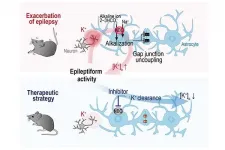Breast cancer screening recalls: simple MRI measurement could avoid 30% of biopsies
Scientific findings instantly applicable in clinical practice
2021-03-01
(Press-News.org) Breast cancer is the commonest fatal cancer in women. Early detection increases a woman's chances of recovery. Magnetic Resonance Imaging (MRI) is an accurate technique for detecting and classifying tumours in breast tissue. However, it sometimes causes "false alarms", thus requiring further investigation (biopsy) and in some cases even resulting in so-called overtreatment, that is to say unnecessary surgery. For the first time, a research team from MedUni Vienna has now confirmed a threshold value for a non-invasive imaging biomarker. This can be incorporated into short standard MRI scans and could reduce the biopsy rate following MRI scans by 30%. Since the infrastructure for this measurement already exists in every radiological facility in Austria, the biomarker could be immediately deployed countrywide.
MRI for early detection, where there is an elevated breast cancer risk, or to complete diagnosis in the event of an unclear mammogram, is the most accurate method for diagnosing breast cancer. But this comes at a price: in one to two out of every ten women, there is a false alarm due to tissue changes that resemble breast cancer on the MRI scan. A biopsy of the breast tissue is then taken for diagnostic purposes, to rule out the presence of cancer. For many women, these biopsies cause considerable physical and emotional stress, as well as generating additional costs. A study conducted by a multi-centre and multi-national working group led by MedUni Vienna has now shown that a particular threshold value (ADC) in a special MRI technique, diffusion-weighted imaging (DWI), can indicate whether or not it is necessary to take a biopsy from the suspected lesion. In future, this could avoid one third of unnecessary biopsies following MRI.
Immobile and "dancing" molecules
MRI uses strong magnetic fields to measure the distribution of water molecules in the body. For example, this can be used to visualise various structures in the body, such as blood vessels, and show them as sectional images. In contrast-enhanced breast MRI, the blood circulation in the tissue is measured. The technique is extremely accurate but, in some cases, it is difficult to say whether identified nodes are malignant or whether the tissue is just well supplied with blood due to other e.g. inflammatory reasons.
A second MRI technique, diffusion-weighted imaging (DWI), maps the motion of water molecules in the investigated structures and can also measure it objectively by means of the apparent diffusion coefficient (ADC). The study team has integrated the DWI technique in with their conventional MRI protocol.
Paola Clauser, Department of Biomedical Imaging and Image-guided Therapy of the MedUni Vienna and Vienna General Hospital, member of the Comprehensive Cancer Center (CCC) of the two institutions and lead author of the study, explains: "DWI enables us to characterise lesions much better. Because: hydrogen molecules "dance" faster in healthy tissue than they do in malignant tumours. Carcinomas alter tissue on a microscopic scale and thereby inhibit the motion of water molecules. We have now shown that we do not need to take biopsies from breast tumours, if the threshold value (ADC) is equal to or greater than 1.5+10-3 mm2/s."
Only three more minutes
DWI only takes a maximum of three minutes but improves diagnosis considerably. Pascal Baltzer, Department of Biomedical Imaging and Image-guided Therapy, MedUni Vienna and Vienna General Hospital, member of the CCC and principal investigator explains: "The multicentre study enabled us to establish this threshold value as an objective, standardised biomarker. It can be used anywhere, since it is largely independent of the equipment, the experience of the radiologist, the measuring time and the measuring technique." DWI is now well established in the diagnosis of stroke and is becoming increasingly popular in cancer diagnostics as well. Every radiological facility is therefore able to carry it out. Baltzer explains: "Our finding can be used immediately for diagnostic purposes. It does not require a special centre - every registered radiology department would be able to use it straightaway."
Successful conclusion to a decade of research work
Study leader Balzer has already spent several years investigating whether diffusion is reduced in a tumour, whether this can be measured and, if so, how. This also applies to the ADC threshold value mentioned above. Thomas Helbich, Department of Biomedical Imaging and Image-guided Therapy MedUni Vienna and Vienna General Hospital, CCC board member and research group leader comments: "This finding is the culmination of more than a decade of research work. We established, researched, refined and evaluated the technique in house, and have published countless studies relating to it. However, it was only in this project that we succeeded in clearly validating and establishing the threshold value. Our next goal is to improve the standard we have now established, thereby potentially reducing biopsies even further."
INFORMATION:
The paper was recently published in the leading journal Clinical Cancer Research.
ELSE PRESS RELEASES FROM THIS DATE:
2021-03-01
Without electronics and photonics, there would be no computers, smartphones, sensors, or information and communication technologies. In the coming years, the new field of phononics may further expand these options. That field is concerned with understanding and controlling lattice vibrations (phonons) in solids. In order to realize phononic devices, however, lattice vibrations have to be controlled as precisely as commonly realized in the case of electrons or photons.
Phononic cyrstals
The key building block for such a device is a phononic ...
2021-03-01
Tohoku University scientists and their colleagues in Germany have revealed that a first-time exposure to only a brief period of brain hyperactivity resulted in an acute breakdown of the inter-cellular network of glial cells. Pharmacological intervention of the glial plasticity may provide a new preventative strategy for fighting epilepsy.
The findings were detailed in the Journal of Neuroscience.
Epilepsy is a disorder characterized by neuronal hyper-excitation and a progression of seizures with each episode. Anti-epileptic drugs are mostly aimed at suppressing hyperactivity, ...
2021-03-01
Results of a 2018 multirocket launch at Poker Flat Research Range north of Fairbanks, Alaska, will help scientists better understand the impact of more water vapor accumulating near the fringe of the Earth's atmosphere.
"This is the first time anyone has experimentally demonstrated that cloud formation in the mesosphere is directly linked to cooling by water vapor itself," said Irfan Azeem, space physicist at Astra LLC in Louisville, Colorado, and principal investigator of the Super Soaker mission.
The NASA-funded project, named Super Soaker, ...
2021-03-01
In recent years, European forests have suffered greatly from extreme climate conditions and their impacts. More than half of Europe's forests are potentially at risk from windthrow, forest fire, insect attacks or a combination of these. This is the main result of a study by an international team of scientists with the participation of Henrik Hartmann from the Max Planck Institute for Biogeochemistry in Jena, Germany. Using satellite data and artificial intelligence, the scientists studied vulnerability to disturbances in the period between 1979 and 2018. In the light of ongoing climate change, their findings are very important for improving mitigation and adaptation strategies ...
2021-03-01
Materials called perovskites can be more readily incorporated into silicon-based semiconducting platforms by using a microfluidic pumping technology developed at KAUST.
The perovskites currently being explored for many applications in new technologies are diverse materials sharing the same crystalline structure as the natural mineral perovskite. These semiconducting materials show great promise in a variety of optoelectronic applications, such as light emitters, sensors and solar cells.
Compared to traditional semiconductors, perovskites are soft and unstable. "This makes it difficult to pattern them using standard lithography methods," says materials scientist Iman Roqan at KAUST.
The challenge tackled by Roqan and her colleagues was to adapt microfluidic technologies to manipulate ...
2021-03-01
COLUMBUS, Ohio - Parents may fear that if their high school student isn't motivated to do well in classes, there's nothing that will change that.
But a new study that followed more than 1,600 students over two years found that students' academic motivation often did change - and usually for the better.
Results showed that increasing students' sense of "belongingness" in school was one key way of increasing academic motivation.
"Our results point to a more hopeful picture for students who start out with lower levels of motivation - they tend to shift toward more adaptive ...
2021-03-01
March 1, 2021 - A new paper published online in the Annals of the American Thoracic Society discusses how smoking may affect risk for COVID-19 and the types of research that are needed to better understand the link between smoking and COVID-19 risk.
In "Smoking and COVID-19: The Real Deal," Enid Neptune, MD, and Michelle N. Eakin, PhD, of the Division of Pulmonary and Critical Care Medicine, Johns Hopkins University, discuss research to date on this topic and propose areas of research that can help clarify this relationship.
Studies have shown that current smokers with COVID-19 have twice the ...
2021-03-01
New research has determined the prevalence of private security systems may be robbing the general public of the police services they need.
Dr. Ross Hickey is an economist in UBC Okanagan's Faculty of Management and the Irving K. Barber Faculty of Arts and Social Sciences. Along with a team of researchers, Hickey examined data from a social survey of Canada victimization, where people answered whether they had added security measures to their homes to protect themselves from crime.
"We are seeing more expenditures on private security systems installed in homes and, as economists, we have to ask why. We know that crime rates are down and expenditure on police is up," says Hickey. "But private security purchases are at an all-time ...
2021-03-01
CORVALLIS, Ore. - Selectively cutting trees in riparian zones to aid forest restoration can be done without adversely affecting streams' water temperature as long as the thinning isn't too intensive, new research by Oregon State University shows.
Published in PLOS One, the study led by OSU College of Agricultural Sciences graduate student David Roon is one of the few to quantify restorative thinning's effects on forest streams.
"We don't know much about what happens with the more subtle changes in shade and light that come with thinning," Roon said. "Most of the research so far has looked at the effects of clearcutting with no stream-side buffer at all, or harvests outside of an untouched buffer area. And regulatory requirements ...
2021-03-01
Around 2.5 billion years ago, our planet experienced what was possibly the greatest change in its history: According to the geological record, molecular oxygen suddenly went from nonexistent to becoming freely available everywhere. Evidence for the "great oxygenation event" (GOE) is clearly visible, for example, in banded iron formations containing oxidized iron. The GOE, of course, is what allowed oxygen-using organisms - respirators - and ultimately ourselves, to evolve. But was it indeed a "great event" in the sense that the change was radical and sudden, or were the organisms alive at the time already using free oxygen, just at lower levels?
Prof. Dan Tawfik of the Weizmann Institute of Science's Biomolecular Sciences Department explains that the dating of the GOE ...
LAST 30 PRESS RELEASES:
[Press-News.org] Breast cancer screening recalls: simple MRI measurement could avoid 30% of biopsies
Scientific findings instantly applicable in clinical practice




